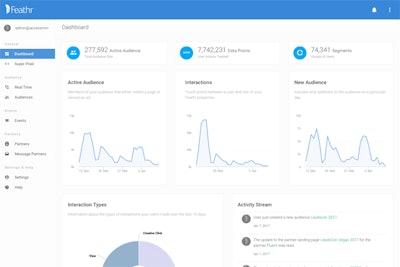
If you spend any time browsing products from online retailers, you have likely experienced retargeting. It’s the term for that seemingly magical way that products you looked at—a coat on Amazon for example—suddenly appear in ads in your Facebook feed and on other websites you visit. Advertisers hope that by seeing that coat again and again, you will eventually decide to purchase it. That same strategy can also be used by planners who are trying to grow the audience for their events.
“People who are trying to grow their events should use every tool at their disposable, and retargeting is a particularly effective one that for some reason has been neglected by the event industry. It is great for attendee acquisition,” says Aidan Augustin, co-founder and president of Feathr, which provides digital marketing solutions specifically for events, including C.E.S. and New York Comic Con. “Usually people don’t end up on an event website by accident. They were probably led there by a search, or they were led there by a social post, or they typed it in directly. So if people are visiting an event website, they are signaling interest. Retargeting is just a way of converting those people who already expressed interest … into registering.”
“Breadcrumbs” is the term Augustin uses for bits of traceable data that Web users leave as they visit websites, like pages on Facebook, use hashtags on Twitter, and more. Digital marketing solutions track specific pages you visit, how much time you spend on those pages, your IP address, and more, and then show you ads that are aligned with those interests.
“For example, all that information is tracked when you are on the New York Comic Con website,” he says. “Now Comic Con can say, 'I want to nudge this person, I want to bring them back to my site because I know they didn’t complete the ticket purchase process.' And so their ads will start showing up wherever you go.”
Augustin says it is important to track not only what people do on your event website, but also when they are visiting in relation to the event. A person who visits the site several times in the weeks leading up to the event is sending a stronger signal about purchasing probability than someone who visits many months in advance.
The process for ad placement is known as real-time bidding. Digital marketing platforms like Feathr coordinate that bidding through ad exchanges, which are online marketplaces that match advertisers’ criteria—who they want to reach and how much they are willing to spend—with websites that have advertising slots to sell. But unlike traditional advertising, real-time bidding is done just as it sounds—in real time. “In a split second an auction takes place, and whoever wins at auction, that’s what determines what ad loads on the website,” Augustin says. “This is why if you and I go to Facebook right now, we’ll see the exact same number of ads—the number of ad slots is predetermined—but you will see different ads than I will see on Facebook, on NYTimes.com, on any website that’s advertising-driven, which is the majority of websites on the Internet.”
In addition to using retargeting to promote their events, Augustin says planners can also create a revenue stream by charging sponsors and exhibitors a fee to have their ads shown to registered attendees in the weeks leading up to an event. “So it’s time-sensitive exposure to the exact same people they are interested in reaching, because they are paying to have a physical presence in front of that same group of people,” he says.
An example would be a brand such as Samsung that wants to promote a launch event at C.E.S. “For the four weeks leading up to the event, all the attendees would see ads from Samsung following them around the Internet saying, ‘Looking forward to seeing you at our C.E.S. activation. Click here to get your spot in the after-party sponsored by Samsung,’ or whatever the call to action is. That’s the monetization of the digital audience of a live event, which we think has a lot of potential.”



















